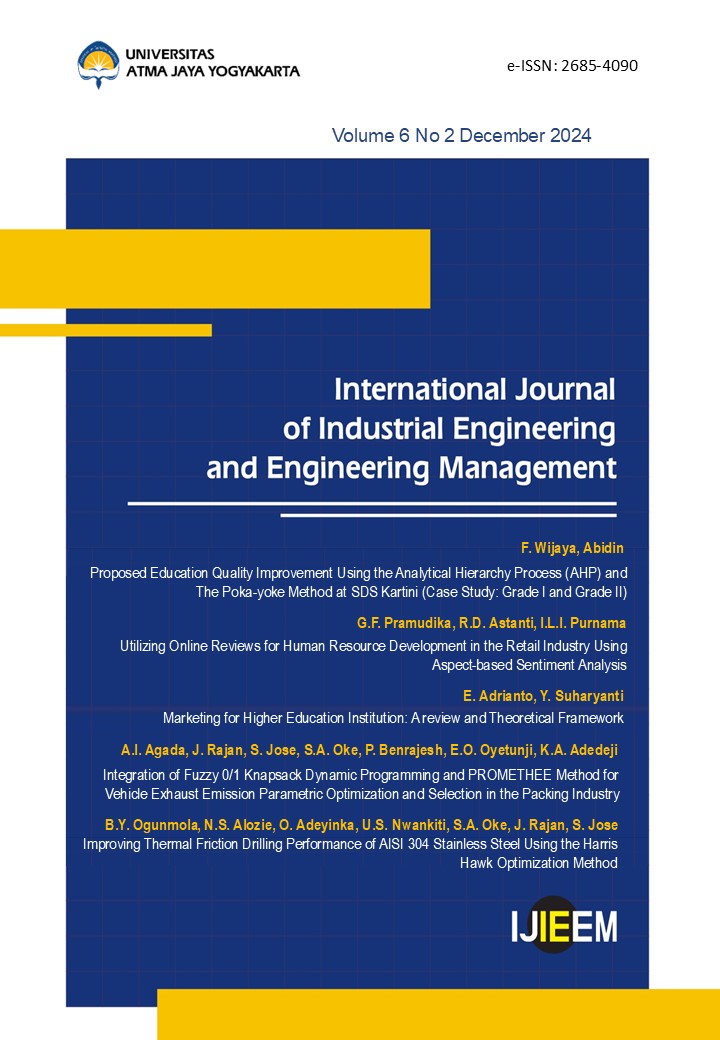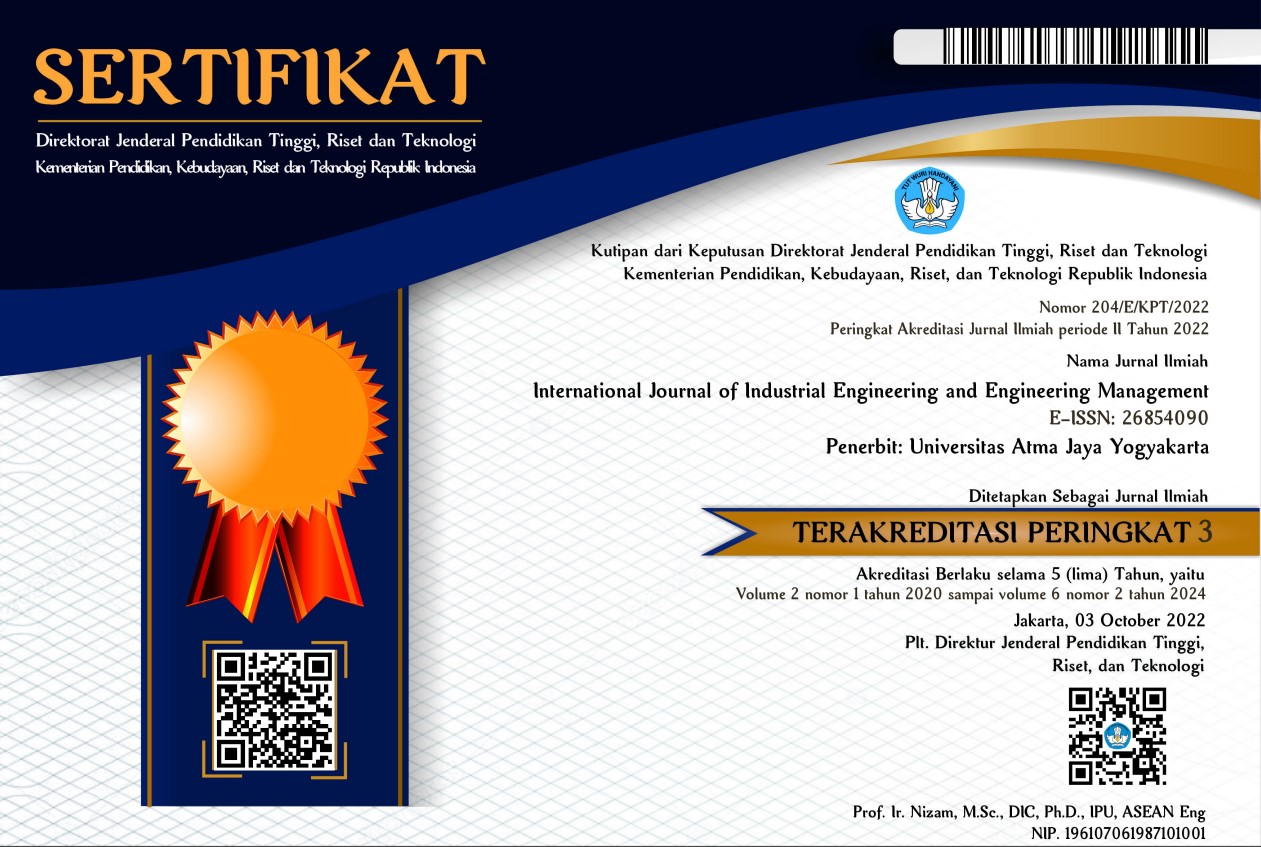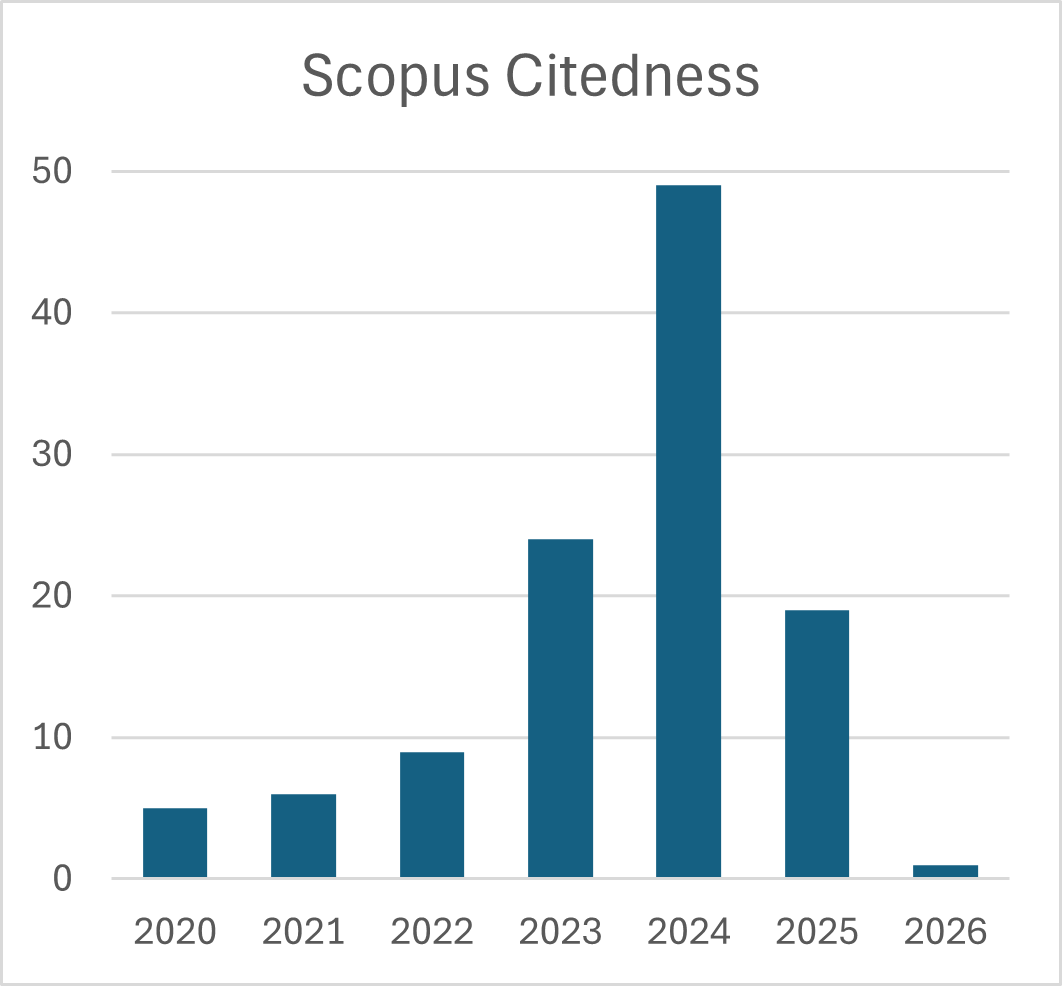Proposed Education Quality Improvement Using the Analytical Hierarchy Process (AHP) and the Poka-yoke Method at SDS Kartini (Case Study: Grade I and Grade II)
DOI:
https://doi.org/10.24002/ijieem.v6i2.9445Keywords:
analytical hierarchy process (AHP), poka-yoke, quality of educationAbstract
Since everything in this world is mortal and ultimately ends, life here is valuable for making a positive contribution. Early in life, one must obtain an educational or learning process to contribute positively. SDS Kartini is a service industrial institution in the basic education field, which consists of six levels or grades. However, in the implementation, the development of students in grades I and II at SDS Kartini is still less than optimal. Next, since human resources are mostly involved in the learning process performances, the poka yoke method is used to prepare the improvement solution. Then, at the procedure of the poka yoke method, there is a stage for choosing the best solution. The analytical hierarchy process (AHP) method can be applied to determine the best solution. Based on the opinions of several education practitioners (class teacher, Chairman of Foundation, and school accreditation assessor) and the calculations using the analytical hierarchy process (AHP) method, the best solution obtained is that the teacher must establish good relationships with the parents or guardians of the students. To reach that goal, a standard operating procedure (SOP) or workflow focused on optimizing attendance records has been proposed. That proposed solution is named "HADIR", where "HADIR" stands for harmonization, assistance, declaration, inspection, and repetition.
References
Abidin. (2021). Determining prospective coconut shell products using the analytical hierarchy process (AHP). Journal Tech-E, 4(2), 1–7.
Agustina, A., Nisa, K., & Sukamta, S. (2019). Penggunaan analytical hierarchy process (AHP) untuk pemilihan supplier bahan baku. Jurnal Sistem Informasi Bisnis 01, 9(1), 86–93.
Ahmad, A. A., Rashid, A. A., Wong, F. R., & Iqbal, M. (2017). Worker safety improvement at paper pleating production line using poka-yoke concept - A case study in the automotive industry. Journal of Mechanical Engineering, 4(5), 183–196.
Ahmad, N., & Qahmash, A. (2020). Implementing fuzzy AHP and FUCOM to evaluate critical success factors for sustained academic quality assurance and ABET accreditation. PloS One, 15(9), Article e0239140.
Ahmad, R. (2018). Penggunaan sistem pendukung keputusan dengan menggunakan metode analytical hierarchy process (AHP) dalam menyeleksi kelayakan penerima beasiswa. METIK Jurnal, 2(1), 28–33.
Ardi, S., Nurdin, M. A. R., & Ponco, A. (2018). Design of poka yoke system on the process of mounting actuator bracket based on programmable logic controller in automotive manufacturing industry. Paper presented at the 3rd Annual Applied Science and Engineering Conference (AASEC) 2018, Bandung, Indonesia.
Barcelona, A. B. (2020). An analytic hierarchy process for quality action research in education. International Journal of Evaluation and Research in Education, 9(3), 517.
Budiani, B., Permana, F., Fadlisyah, H., & Fauzi, M. (2020). Standarisasi pelabelan menggunakan metode poka yoke untuk menghindari larutan kadaluarsa. Jurnal Teknik Industri Universitas Widyatama: Profisiensi, 8(2), 105–115.
Bumjaid, S. E., & Malik, H. A. M. (2019). The effect of implementing of Six Sigma approach in improving the quality of higher education institutions in Bahrain. International Journal of Engineering and Management Research, 9(2), 134–140.
Departemen Pendidikan Nasional. (2007). Panduan penyelenggaraan Sekolah Standar Nasional untuk Sekolah Dasar. Jakarta, Indonesia: Departemen Pendidikan Nasional.
Fahim, A., Tan, Q., Naz, B., Ain, Q. U., & Bazai, S. U. (2021). Sustainable higher education reform quality assessment using SWOT analysis with integration of AHP and entropy models: A case study of Morocco. Sustainability, 13(8), 4312.
Fenty, D.J. (2020). Exploring the relationship between self-efficacy, academic success and persistence for adult undergraduate students in urban universities. Cleveland State University.
Khorasani, S. T., Feizi, R., & Tohidi, H. (2018). The effect of poka yoke implementation on intravenous medication error in hospital inpatient pharmacy. Paper presented at the 2018 IISE Annual Conference K. Barker, D. Berry, C. Rainwater, Eds., Orlando, Florida.
Liu, J. (2018). Constructing resource sharing collaboration for quality public education in urban China : Case study of School Alliance in Beijing. International Journal of Educational Development, 59(July 2017), 9–19.
Maulivia, V. S., & Rimantho, D. (2019). Strategi pengambilan keputusan peningkatan kualitas produksi part Joint Rubber S BH17 dengan etode FMEA dan AHP. Jurnal Rekayasa Dan Optimasi Sistem Industri, 1(1), 32–38.
Muharam, M., & Latif, M. (2019). Design of poka yoke system based on fuzzy neural network for rotary machinery monitoring. IOP Conference Series: Materials Science and Engineering, 602, Article 012003.
Patria, R., Wulandari, A., Tyas, S. K., & Hasibuan, S. (2019). Poka-yoke in collaborative inventory practice to reduce action in automotive manufacturing. International Journal of Scientific and Engineering Research, 10(6), 1196–1201.
Ponsiglione, A. M., Amato, F., Cozzolino, S., Russo, G., Romano, M., & Improta, G. (2022). A hybrid analytic hierarchy process and likert scale approach for the quality assessment of medical education programs. Mathematics, 10(9), Article 1426.
Ramaditya, M., Maarif, S., Sukmawati, A., & Affandi, M. J. (2021). Fuzzy analytical hierarchy process for selecting priority strategies in improving private higher education performance. Qualitative and Quantitative Research Review, 7(1), 22–44.
Rohmah, N., Hidayat, S., & Nulhakim, L. (2021). Implementasi pendidikan karakter disiplin dalam mendukung layanan kualitas belajar siswa. Jurnal Ilmiah Pendidikan dan Pembelajaran, 5(1), 150–159.
Romlah, O. Y., & Latief, S. (2021). Empowering the quality of school resources in improving the quality of education. Bulletin of Science Education, 1(1), 37-41.
Saggaf, M. S., Akib, H., Salam, R., Baharuddin, A., & Kasmita, M. (2018). The quality analysis of academic services. Paper presented at The 1st International Conference on Social Science and Humanities (ICSS) 2018, Bali, Indonesia.
Sari, L. (2020). Upaya menaikkan kualitas pendidikan dengan pemanfaatan Youtube sebagai media ajar pada masa pandemi COVID-19. Jurnal Tawadhu, 4(1), 1074–1084.
Setiawati, F. (2020). Manajemen strategi untuk meningkatkan kualitas pendidikan. Jurnal At-Tadbir: Media Hukum Dan Pendidikan, 30(1), 57–66.
Suhaimi, M. F. M., & Salleh, N. A. M. (2018). A case study on the improvement of productivity and efficiency of a quality control line for a cutting tool manufacturer. Journal of Mechanical Engineering, 5(1), 222–239.
Wang, X.Y., Li, G., Tu, J.F., Khuyen, N. T. T., & Chang, C.Y. (2021). Sustainable education using new communication technology: Assessment with analytical hierarchy process (AHP). Sustainability, 13(17), Article 9640.
Wati, H. M. (2021). Pemilihan akar penyebab kecacatan produk Midsole Saucony menggunakan metode analytical hierarchy process (AHP) dan usulan perbaikannya di PT. Hefah Indonesia Subur. (Bachelor Thesis, Universitas Buddhi Dharma).
Yashini, J. (2020). An analysis on minimization of product error (poka yoke) and excess work in progress (TPM & OEE) in textile industry. International Journal of Research in Engineering, Science and Management, 3(9), 17–22.
Yuan, M., & Li, C. (2021). Research on global higher education quality based on BP neural network and analytic hierarchy process. Journal of Computer and Communications, 09(06), 158–173.
Downloads
Published
How to Cite
Issue
Section
License
Copyright (c) 2024 Felicia Wijaya, Abidin

This work is licensed under a Creative Commons Attribution 4.0 International License.








